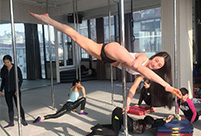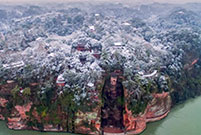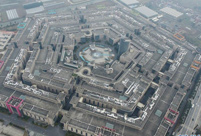

People are attracted to the New Year paintings in the 'Folk Fine Arts Works Exhibition' held in the Zhengjue Gallery in Hebei province. (CNS/Zhai Yujia)
Xu Xiaoyi is a 35-year-old artist of New Year paintings in Wuqiang county, northern China's Hebei province. In the 'Folk Fine Arts Exhibition' held in the Zhengjue Gallery of Hebei province, Xu displayed his New Year paintings and presented the production techniques.
Making New Year paintings was a kind of folk art in agricultural society. Xu learned this particular art from Ma Xiqin, the representative successor of New Year wood engraving pictures,a Chinese national intangible cultural heritage. "Posting the New Year paintings used to be a rather important activity at Spring Festival, people always cleaned their house and decorated their rooms with their favorite paintings," said Xi.
With the development of society and changes to people’s living environment, the market demand of New Year paintings is much smaller than before. "My family stopped putting up the New Year paintings after my grandma passed away. Due to low income expectation, few young people show an interest in the New Year paintings and learning the skill. Passing on the skill of New Year paintings is facing a crisis," said Xu.
Xu innovates with his New Year paintings by putting in new elements such as the Olympic Games and World Expo. "Wuqiang New Year paintings never stopped being passed down from the end of Yuan Dynasty to the beginning of Ming Dynasty. We will only inherit this art through continuous innovation," said Xu.
A mother happily plays the kite with her child in the exhibition. (CNS/Zhai Yujia)
 |
 Have you ever taken these beautiful subways in China?
Have you ever taken these beautiful subways in China? Chinese beauties, foreign models meet in Chengdu
Chinese beauties, foreign models meet in Chengdu Awesome! Aerial pictures taken on J-11 fighter
Awesome! Aerial pictures taken on J-11 fighter A foreign girl explains what China should be proud of
A foreign girl explains what China should be proud of Chinese navy's air-cushioned landing craft in pictures
Chinese navy's air-cushioned landing craft in pictures Chinese pole dancing master opens class in Tianjin
Chinese pole dancing master opens class in Tianjin Splendid Sichuan after snow
Splendid Sichuan after snow College girl of Vancouver crowned Miss Chinese Int'l 2016
College girl of Vancouver crowned Miss Chinese Int'l 2016 Pentagonal Mart becomes the largest vacant building in Shanghai
Pentagonal Mart becomes the largest vacant building in Shanghai Top 20 hottest women in the world in 2014
Top 20 hottest women in the world in 2014 Top 10 hardest languages to learn
Top 10 hardest languages to learn 10 Chinese female stars with most beautiful faces
10 Chinese female stars with most beautiful faces China’s Top 10 Unique Bridges, Highways and Roads
China’s Top 10 Unique Bridges, Highways and Roads Buying nianhuo!
Buying nianhuo! What Chinese try to sneak on flights (and how)
What Chinese try to sneak on flights (and how) Northeast authorities vow they will work to eradicate GM grains
Northeast authorities vow they will work to eradicate GM grains China’s richest village manages to transition away from old industries
China’s richest village manages to transition away from old industriesDay|Week